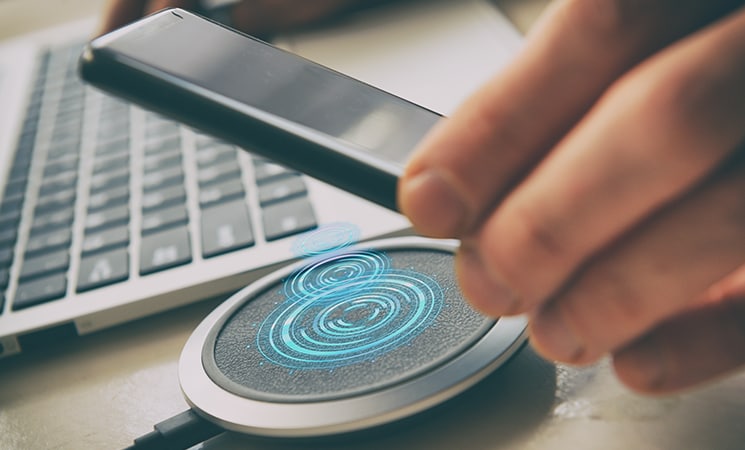The Benefits of Becoming a Qi® 1.3-Certified Transmitter Manufacturer
After there was a need for safety and security implementations in Qi® charging, Microchip provided their expertise to the Wireless Power Consortium to help develop an updated version of the wireless charging standard. With this updated version, the importance of becoming Qi certified has never been more apparent.
Qi 1.3 Wireless Charging With Authentication
Phone manufacturers who have had concerns with the quality of a Qi® charger can now validate the authenticity of the charger before requesting power levels of up to 15W from the charger, thanks to the recently released Qi 1.3 specification.
Authentication Between the Charger and Receivers
The Wireless Power Consortium (WPC) decided to mandate authentication between the charger and receivers to ensure that receivers are charged by certified and authenticated do-no-harm power transmitters. Once this authentication mandate was defined, Microchip provided expertise to the WPC to finalize and deploy the new Qi® 1.3 wireless charging specification. Several customers have begun designing Qi 1.3 transmitters with authentication with guidance and support from Microchip. Here we will look to understand the importance of authentication and how we can help you navigate powertransmitter designs to support authentication.
As of today, almost all smartphone manufacturers have implemented Qi charging. As a result, the ecosystem of Qi transmitters/chargers has also grown providing the user a seamless, high-quality experience of wireless charging. The long-term goal of wireless charging is to not have to carry charging cables with your phone. Wireless charging pads will be used ubiquitously—on the nightstand, in the car, at office desks and at coffee shops/restaurants and enable the ability to charge your phone throughout the day.
The Qi specification has been evolving since 2010, improving with every new version. The most recent version, Qi 1.3, includes completely restructured specification documents including improved foreign object detection, authentication between the transmitter and the receiver and a substantial number of new compliance tests. Earlier versions of the specification did not have the safety and security benefits which have been implemented in Qi 1.3. Previously, phones implementing Qi 1.2.x requested 15W of power from the charger without knowing if the transmitter was certified or not. This creates a risk to the phone because improper transmitter designs could cause overvoltage or overcurrent scenarios at 15W and potentially damage the phone. By implementing the new Qi 1.3 specification which includes authentication, phones requesting 15W of power can verify that the transmitter is certified per the WPC’s process and can safely request and receive a 15W charge. When a consumer sets their phone on a charger, initially the phone would request 5W of power. While this 5W power transfer is occurring, the phone will now cryptographically authenticate the charger/transmitter using x.509 certificates. If the authentication is successful, the phone can then safely request a higher power charge (15W) from the charger resulting in significantly faster charge times.
WPC Manufacturing Certificate Authority Service Provider
As a licenced WPC Manufacturing Certificate Authority Service Provider (MCSP), Microchip has the ability to provision WPC approved secure storage subsystems that will be recognized and routed all the way up to the root Certificate Authority (CA) within the WPC. After signing the WPC Manufacturer CA agreement on the 11th of March 2021 and being selected as a beta Manufacturing Certificate Authority, Microchip very quickly began to turn things around. We helped the WPC and their designated root certificate authority iron out the whole process, thanks to our decades of experience in provisioning security devices. Microchip then submitted certificate signing requests (CSRs) on behalf of our customers during the first ever WPC Qi 1.3 signing ceremony. These customers and several others since then have had their production certificate chains setup on behalf of Microchip.
As an MCSP, we can help our customers navigate the process of designing a Qi 1.3 charger and becoming a transmitter manufacturer once they have become a member of the WPC. When they are ready to move forward, they can contact the WPC and express their interest in designing a Qi 1.3 charger, whilst at the same time informing them that they have selected Microchip to be their secure storage subsystem and MCSP. From there, once the legalities have been addressed with the WPC, we can take on the burden of setting up the whole certificate chain and provide our Microchip WPC one-stop-shop in which we help with five major components:
- WPC Application MCU dsPIC33Cx
- WPC Qi 1.3 Application Software
- SSS Library Support CryptoAuthLib ECC/TA
- WPC SSS ECC/TA
- WPC MFG CA Provisioning SPG
Having everything covered and bundling these solutions together is extremely advantageous and our technical support can bridge you from the design all the way through to mass production.
To learn more about the benefits and process of becoming a member of the WPC, as well as a power transmitter manufacturer, thereby having the ability to design a certified Qi 1.3 charger, please watch our webinar. Alternatively, contact a Microchip sales representative, authorized worldwide distributor, or visit Microchip’s wireless power web page.
